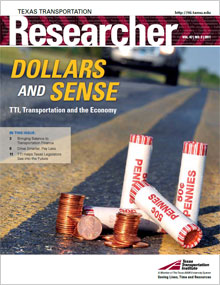TTI Helps Implement TRZs in Texas
A nation’s progress depends in part on transporting goods and services over a safe, reliable road network. With the current state of the national economy, however, public funding for road construction and infrastructure maintenance is rapidly shrinking. This makes finding innovative financing methods even more critical.
One such solution for Texas is presented in the recently passed Senate Bill (SB) 1266, which provides the legal basis for setting up transportation reinvestment zones (TRZs). TRZs facilitate value capture of the tax increment from a future transportation project. An innovative financing tool, value capture leverages real estate potential due to urban asset investments, sort of like “counting your chickens before they hatch” and getting all you can for them ahead of time.
To help make TRZ implementation more acceptable, the Texas Transportation Institute (TTI) conducted a co-sponsored Texas Department of Transportation (TxDOT)/Federal Highway Administration project that promotes ways to understand and implement SB 1266 among Texas agencies. The project team, led by TTI Associate Research Scientist Sharada Vadali and Research Scientist Rafael Aldrete, conducted surveys in Texas cities to document the extent of understanding and knowledge (or lack thereof) regarding the bill’s provisions. This involved compiling actual implementation case examples.
Researchers found a lack of standardized procedures and guidance for TRZ development, so they explored data quality and standards across the state and developed procedures and tools for TRZ stakeholders. Aldrete notes, “We also propose standardized methods of screening TRZ projects to actually develop and implement TRZs, as well as evaluate their revenue potential.”
A second critical finding was a general lack of awareness of TRZs and the provisions of SB 1266. The research team conducted an extensive outreach effort across various organizations in Texas through web-based surveys and telephone calls. “We developed a structural guide for municipalities to implement TRZs so they can assess that potential revenue,” Vadali adds.
The researchers crafted several recommendations to amend SB 1266 for implementing agencies. They then conducted workshops with various agencies to share the research and compiled feedback crucial to finalizing recommendations.
The legislation was finalized in the most recent legislative session, resulting in House Bill 563. Updates include simplifying requirements to establish a TRZ and significantly expanding the types of transportation improvements eligible for funding, from roads only to any other transportation project. According to Aldrete, “Given these updates, those who were unable to participate in the previous workshops may now wish to attend.”
TRZ is a positive and viable option that provides communities with an additional tool for their highway infrastructure projects — without necessarily adding another tax. Currently, three areas in Texas — El Paso, Forney and Hidalgo Counties — are implementing TRZs.
According to Gerry Leos, project engineer in TxDOT’s El Paso District, “TTI has a lot of staff with much experience and education, so definitely having that sort of team always helps TxDOT. For the TRZ project, TTI has helped us educate people, informing them about this potential funding source and helping them understand and use it.”

